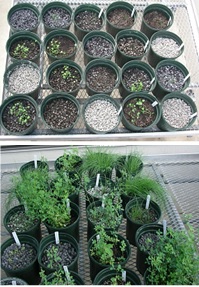Phosphorus Recycling
 PhosphoReduc Technologies capture phosphorus from any pollution source (e.g. both point end of the pipe and diffused sources) at high efficiency and low cost. At the end of the filter designed life time , PhosphoReduc filtration media can be recycled and re-used as a Phosphorus rich soil amendment in forestry, horticulture, acid mine drainage or help establish vegetation for new land developments. Dr Drizo has co-authored a book chapter titled “Phosphorus Recovery and Reuse”. In: Dijk, K. and Yoshida, H. (ed.). Phosphorus, Food and Our Future. To be published by Frontiers in Life Sciences in 2012.
PhosphoReduc Technologies capture phosphorus from any pollution source (e.g. both point end of the pipe and diffused sources) at high efficiency and low cost. At the end of the filter designed life time , PhosphoReduc filtration media can be recycled and re-used as a Phosphorus rich soil amendment in forestry, horticulture, acid mine drainage or help establish vegetation for new land developments. Dr Drizo has co-authored a book chapter titled “Phosphorus Recovery and Reuse”. In: Dijk, K. and Yoshida, H. (ed.). Phosphorus, Food and Our Future. To be published by Frontiers in Life Sciences in 2012.
As a key component of fertilizers, phosphorus is fundamental for the world’s food supplies, and an irreplaceable and essential element of human, animal and plant life with its sole source as phosphate-bearing rocks. The current rate of phosphate extraction is reported at 167 million tonnes per year with a growing demand that accounts for a 2% annual increase. Phosphorus resources are non-renewable with global reserves estimated to reach their peak in the next 50-100 years. As global phosphate reserves continue to decline, the impacts are likely be immense, particularly in terms of rising food prices, growing food insecurity and widening inequalities between developed and developing countries.
For more information please see:
1. The next inconvenient truth: Peak Phosphorus. Arno Rosemarin, Gert de Bruijne, and Ian Caldwell (2009). http://www.thebrokeronline.eu/var/broker/storage/original/application/70be5ff931f74fcea383a3d922f77e98.pdf
2. Peak Phosphorus. Timothy M. Beardsley (Ed.) (2011). BioScience 61(2):91-91.
doi: http://dx.doi.org/10.1525/bio.2011.61.2.1
3. The story of phosphorus: Global food security and food for thought. Dana Cordell, Jan-Olof Drangert, Stuart White (2009). Global Environmental Change 19 (2): 292-305.
